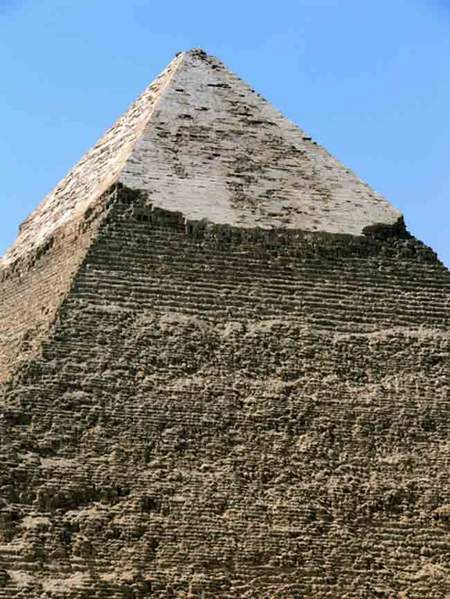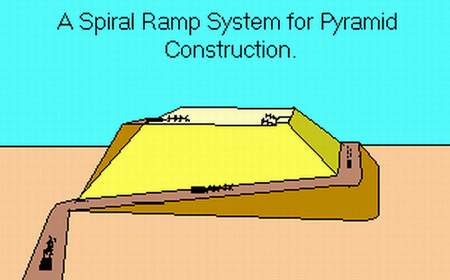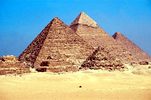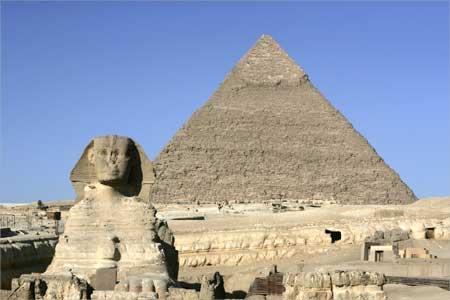|
|
Last scientific discovery stated the following: French and U.S. researchers assert that the huge stones used by the Pharaohs to build the pyramids are just clay that has been heated at high temperatures…
|
Will the pyramids that we know as one of the Seven Wonders survive in the world? Did scientists find an answer to the puzzle of how the pyramids were built in ancient Egypt? Are some people still believe that the Jinn are the builders of these pyramids? Is it possible to believe that creatures from outer space built the pyramids of Egypt? ...
These speculations filled the world and lasted for several centuries, but the new discovery made by scientists from France and America will change the scientists` look forever. It will also give a simple scientific explanation to the mystery of building the pyramids, but more odd is that this mystery has been in the Qur'an fourteen centuries ago!!!
It was believed that the pharaohs have carved the stones but the question here is: How come all the stones are so identical that you cannot find a distance between one stone and another? And where are the equipments and chisels that were used in carving those stones? Until now, they have not been found? This discovery confirms that the scientists were wrong when they thought that the pyramids were built of stones. The nearest answer to logic and truth is to say that the civilization of the pharaohs was built on the clay!!
This is a picture from top of Cheops the Great ` pyramid, as we can notice this pyramid was the highest building in the world with a height up to 146 meters. Millions of stones were used in the construction: each stone weighs several tons. It is an enormous work that gives evidence to the powers the Pharaohs reached before 4500 years ago.
New scientific facts
One of the scientific facts that the great pyramid with the height of 146 meters was the highest building in the world for the last 4500 years and continued until the nineteenth century, The new theory proposed by French Professor Joseph Davidovits, the director of Geopolymer Institute asserts that the pyramids were built mainly of mud and that clay was used as a mean to move the stones on special railway.
The research suggests that the mud and other materials were taken from the Nile`s soil and these materials were put together in tight stone molds .Then they were heated at a high temperature, leading to the interaction of these materials and forming them into stones-like volcanoes stones, which were formed millions of years ago. Scientist Davidovits affirms that the stones which were used to build the pyramids were mainly from limestone, clay and water. The tests made by using Nanotechnology (the branch of engineering that deals with things smaller than 100 nanometers) proved the existence of large quantities of water in these rocks; such quantities do not exist in natural stones.
Furthermore,there is also consistency in the internal structure of stones which confirms that it is unreasonable that these stones were brought, then were carved in this way. The most realistic possibility is that they poured the clay in molds to make identical stones just as today as we pour plastic tools in templates so all the pieces are quite equal and similar.
Electronic microscope was used to analyze samples of the pyramids stones. The result was closer to the opinion of Prof. Davidovits and the quartz crystals appeared clearly as a result of heating the mud. He stated that we don`t have in the nature like these stones which his confirms they were made by the Pharaohs. The analysis by Mini E scale indicated the presence of silicon dioxide too. This is another proof that the stones are not natural.
The picture shows Professor Michel Barsoum standing next to the Great Pyramid. He stress that these stones were poured into molds of clay! This what he proved in his researches after results of long experiments that these stones are not natural. Pro. Michel Barsoum confirmed after Electronic microscope analysis that they are a result of a quick interaction between clay, limestone and water at high temperatures.
Davidovits famous book entitled “Ils ont bati les pyramides” ,published in France in 2002, has resolved all problems and puzzles which were told about the way that the pyramids were built. Moreover, he put a simple geometric construction mechanism of mud. It was very convincing to many researchers in this field of science. Some researches emphasized that furnaces or stoves were used in ancient times to make ceramics and statues. The common use of fire was to build status of clay, mixed with metals and natural materials. After that, they lit a fire until the statue solidifies and takes the shape of real rocks. Many civilizations used the heated clay for making stones, statues and tools. All researches confirmed the this method used by the pharaohs in high buildings such as pyramids.
They made wooden rails that went round the pyramid in a spiral way like the grapes tabernacle which grows around itself and ascends to the top.
Other researches reach the same result
Other analysis using X-ray proved existence of air bubbles in the samples taken from the pyramids which were formed during the pouring stones from mud and evaporation of water from mud. Furthermore, these bubbles do not exist in natural stones and this adds new evidence that the stones are made of clay and limestone not older than 4700 years.
Mario Collepardi, an Italian Prof. studied the architecture of the pyramids, emphasized that the Pharaohs brought the limestone dust available a lot in their area, mixed it with normal soil. Then they added water from the river Nile and lit fire to a temperature up to 900 degrees Celsius. This heat gave the stone strength and a shape similar to natural rocks.
The new idea does not cost a lot of effort because workers will not carry and raise any stones, all they have to do is to make the templates in which they pour mud and transfer mud from the ground and raise them in small containers. Each worker carries a container with mud to fill the templates. Then comes the process of lighting fire until the stone is shaped and stayed in place making sure by this way that there are no spaces between the stone and the other. Using this method helped in keeping the pyramids safe for thousands of years.
The picture shows two adjacent stones of the pyramid's stones. We can notice the small oval cavity between them which is referred to by the arrow. It is a proof that the stones had been poured from mud in the rock template because this cavity was formed during casting stones, not as a result of erosion. It is originally out of these stones.
The Scientific fact corresponds with the Quran
After all these facts, we can reach to this result, which is: the technique used in the Age of the Pharaohs to build massive buildings such as pyramids, was mainly using the normal mud available near the River Nile. Then mixing it with water, placing it in templates and finally lighting the fire until it solidifies and stones are shaped the way we see today.
This technique remained hidden as a secret until 1981, when that scientist put his theory. Then in 2006, other scientists proved the validity of the theory, beyond any doubt, by laboratory analysis, this technique was entirely unknown at the time of Quran. But what does the Quran say? Let`s my brothers and sisters consider and praise Allah, Almighty.
After Pharaoh has become an oppressor and declared himself as a God of Egypt!! What did he say to his people, consider this:“Fir‘aun (Pharaoh) said: "O chiefs! I know not that you have an ilâh (a god) other than me.”( AlQassas : 38). To that extreme extent, his challenge and arrogance reached. However, the Pharaoh did not stop, he wanted to challenge God`s power and build a high monument in order to climb it to see who is Allah Almighty. Therefore, the Pharaoh wanted to prove to his people, the ones who were like him, that Moses (peace be upon him) is not honest, and that the Pharaoh is the only God of the universe!!
The pharaoh asked Haman, his deputy and partner, to build a huge monument to prove to the people that God does not exist. Here Pharaoh resorted to the technique used at that time in construction which was lighting fire on stones in order to pour the needed stones for the monument. The Pharaoh said after that: “So kindle for me (a fire), O Hâmân, to bake (bricks out of) clay, and set up for me a Sarh (a lofty tower, or palace) in order that I may look at (or look for) the Ilâh (God) of Mûsâ (Moses); and verily, I think that he [Mûsâ (Moses)] is one of the liars."( AlQassas : 38).
But what was the result? Look and think of the fate of the Pharaoh, Haman and their soldiers, the Almighty says: (And he and his hosts were arrogant in the land, without right, and they thought that they would never return to us * So We seized him and his hosts, and we threw them all into the sea (and drowned them). So behold (O Muhammad (peace be upon him)) what was the end of the Zâlimûn [wrong-doers, polytheists and those who disbelieved in the Oneness of their Lord (Allâh), or rejected the advice of His Messenger Mûsâ (Moses) (peace be upon him]. .( AlQassas : 39-40).
One might ask, is the monument the same as the Pyramid? We say it is not often. The monument is high as a tower or high lighthouse used in order to ascend to high altitude. Allah punished the Pharaoh and destroyed him. Allah Almighty also destroyed his monument to be a verse for the ones who comes after him. This monument that he build to challenge God was destroyed and we do not find it anywhere. The story of the Pharaoh and his black fate was told by Allah in this verse: “And we destroyed completely all the great works and buildings which Fir‘aun (Pharaoh) and his people erected.” ( Al Aaraf: 137 ). Already some scattered stones were found buried by sand during thousands of years.

The picture shows one of the three pyramids at Giza with the top still covered by a layer of mud. This layer is from the same stone used in building; which indicates that clay was fully used in building the pyramids. This “ Pharaonic technology” was perhap a secret of the strength of the pharaonic civilization and kept on as a secret not mentioned even in manuscripts and inscriptions. Therefore, the Qur'an tells us about one of the hidden secrets that cannot be known only to Allah, and this is strong evidence that the Koran is the book of Allah!
The miracle
1. This researcher and other dozens of researchers confirm that clay is the building material of the pyramids, and these buildings are the highest buildings, known from ancient history to the modern era. All these facts confirm that the Quran verse is true and consistent with science and one of the verses of the scientific miracles.
2. The technology of making stones from mud using heat, was not known at the time of revelation of the Qur'an and the Prophet Muhammad (peace be upon him) did not have any knowledge about the way of building the pyramids. Accordingly, this verse is to be considered a great scientific discovery as it linked between the mud and heat as a means of building in the Age of the Pharaohs. On the account of this fact, it led us to know that construction at that time was based on this method. This scientific fact has not been recognized only a few years ago by using very advanced technologies!
3. This miracle is an evidence of full consistency between the Qur'an and science and truthfulness of Allah Almighty when He said about his book: “Do they not then consider the Qur’an carefully? Had it been from other than Allâh, they would surely have found therein many a contradiction.”(Al Nisaa:82) The verse is a response to the atheists who claim that the Quran was written by Mohammed (peace be upon him), as how can he predict such a matter as the pyramids are far from his time and he never see it before!
4. he certain facts confirm that the Greatest Pyramid in Giza or the so-called pyramid of Cheops was the highest building on earth for 4500 years. It was the Pharaohs famous buildings or monuments. Allah destroyed the monuments and buildings built by the Pharaoh, who claimed divinity, whereas pyramids which were built by other Pharaohs were saved by Allah and kept as a witness of truthfulness of the Book of Allah, the Almighty!
5. In the verse “And we destroyed completely all the great works and buildings which Fir‘aun (Pharaoh) and his people erected.” Look at the word (erected) which indicates the technique used in ancient Egypt to put the rocks on top of each other! In Arabic language we find the word in “Al Qamoos Al Muhid” dictionary:(erected) build an arbor, (erected the grape arbor: raise the plant on wood, (erected) the house: build the house, put the roof. The result: the word (erected) refers to putting the wood to raise stones up. That whatscientists and researchers say today: the Pharaohs used the wooden rails to raise mud by climbing in a spiral way around the building just like a pergola, which wrap around the pillar upon which it is based on in a spiral way.

The drawing shows the way of building the pyramids through the placing wooden rails in a spiral way in order to transfer mud to make stones, wrapping around the pyramid up just like the bowers grape that wrap around and climb. Allah Almighty used the word (erected) to indicate the geometrical mechanism of constructing buildings and monuments. Mostly destroyed by Allah, leaving only the pyramids to be evidence of the truthfulness of the Qur’an
6. This miracle is an answer to those who claim that our greatest prophet (peace be upon him) took the Sciences and stories from the Bible or from Monk ‘Buhira” or the priest “Waraqa bin Nawfal”, because the technical construction by mud was not mentioned in the holly Book “AlTorah”.On the contrary, any reader of “Torah” comes to a conclusion that stones were brought in from places far from the Pyramids and were natural stones not related to mud. This is what prevented some western scientists from recognition of this scientific discovery because it contradicts the holly book.
7. The research presented by Professor Davidovits invalidated all biblical (The holly book of Torah) claims that thousands of workers have worked for many years in these pyramids. It also invalidates the idea that stones were brought from distant places to build the pyramids. Therefore, we are looking at physical evidence that the Torah story contradicts science.
It means that there is a big difference between the Holly book of Torah and scientific facts, and this shows that the current copy of Torah is written by humans, not from Allah Almighty. This fact was confirmed by the Quran: " Do they not then consider the Qur’ân carefully? Had it been from other than Allâh, they would surely have found therein many a contradiction. (Al Nisaa: 82). It also indicates that the Quran is from Allah Almighty because it always matches science!
Some questions to those who are skeptics of message of Islam
1. How did Prophet Mohammad peace be upon him know about the presence of high buildings Pharaohs build in their time? And if he has derived his information from the Torah, he would have come to the same information mentioned in the Torah. Where did he come up with the idea of architecture at all?
2. How was the Prophet Mohammad (peace be upon him) aware that technique of clay was used in construction in the Ages of Pharaohs? And what made him talk such historical and metaphysical issues as it would not provide anything to him in his massage. If the Prophet wrote the Quran (as some people claim) it would have been better that he tells them about Arab Legends which are the closet to people to accept his massage!
3. How did Prophet Mohammad (peace be upon him) know that the Pharaoh Claim divinity? And that he build monuments? And how did he learn that these monuments have been destroyed? And only the remains are left as an evidence of their existence in the past. Allah Almighty says: (And those are their dwellings, which have not been inhabited after them except a little. And verily! We have been the inheritors.)(Al Qassas :58)
4. Is it possible If Prophet Muhammad (peace be upon him) wrote the Quran to say such a thing:
“Do they not travel in the land, and see what was the end of those before them? They were superior to them in strength, and they tilled the earth and populated it in greater numbers than these (pagans) have done: and there came to them their Messengers with clear proofs. Surely, Allâh wronged them not, but they used to wrong themselves." (Al Room: 9) Allah Almighty makes contemplating through these pyramids and other ancient monuments remain a mean of realizing Allah`s power and fate of arrogant people who challenge Allah.
These facts are physical proofs reflected in Allah`s holly book that shows the truthfulness of this book, one might say: The theory of building the pyramids by mud had not become a scientific fact, so how do you explain the Quran with such theory, and I say: this theory did not come from a nowhere but it was a result of scientific and laboratory analysis and does not contradict reality. It matches the Quran. However the science develops, it will not discover facts, and only the ones which match the Quran, in order these facts are means of seeing miracles of Allah in his book. He said: "We will show them Our Signs in the universe, and in their own selves, until it becomes manifest to them that this (the Qur’ân) is the truth. Is it not sufficient in regard to your Lord that He is a Witness over all things? (Fusselat: 53.).
--------------------

























